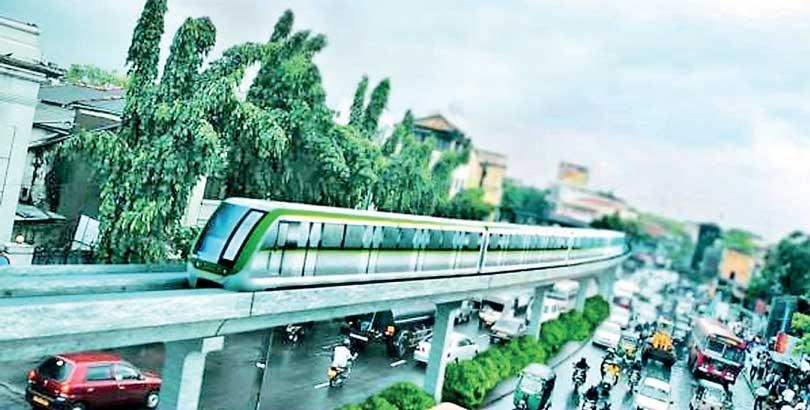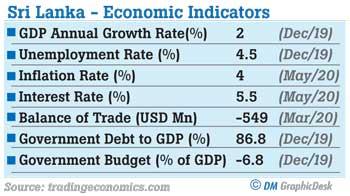Reply To:
Name - Reply Comment
The government has called for debt relief from friendly nations, from India, China and Japan. This had been in the government plans even before the economic fallout of the Covid-19

An artist’s rendering of the LRT project
 These are gloomy times for the economy. The government’s economic mismanagement might make it gloomier.
These are gloomy times for the economy. The government’s economic mismanagement might make it gloomier.
Rent-seeking economic decisions and subordination of the national economic priorities to personal-political ambitions of the political leadership have always been an affliction and left a good number of white elephants, ranging from an airport in the jungle to railroads to nowhere.
Sri Lanka is at the risk of relapsing to that dangerous old habit. In one of the crowning politically instigated blunders, as the sister weekend of this newspaper, Sunday Times reported, the government has informed the Japan International Corporation Agency (JICA) that it would not proceed with the Colombo Light Rail Transit (LRT) project for the next five years, i.e. the entirety of its current term. The rationale is the government does not have the fiscal space to finance its part and it would rather do other urgent economic projects. This should be further looked into.
The LRT is one of the few local projects where an extensive feasibility study was undertaken. (The Japanese on their part do not extend loan facilities on back-of-the-envelope research work). A study by Moratuwa University in 2009 found that the traffic congestion in the Greater Colombo area alone cost Rs 32 billion annually. According to Prof Amal Kumarage, Sri Lanka is losing 1.5% of GDP due to traffic congestion and poor road networks. And the traffic flow is growing at 10% a year.
 In 2017, a feasibility study by JICA for the Malabe corridor found the Economic Internal Rate of Return (EIRR) of the project was more than 20%. The initial investment of the project was estimated at US$ 1.85 billion and is to be financed by JICA under a Special Terms for Economic Partnerships (STEP) loan.
In 2017, a feasibility study by JICA for the Malabe corridor found the Economic Internal Rate of Return (EIRR) of the project was more than 20%. The initial investment of the project was estimated at US$ 1.85 billion and is to be financed by JICA under a Special Terms for Economic Partnerships (STEP) loan.
The loan is provided at an interest rate of 0.1% for construction and equipment per annum, an interest rate of 0.01% for consultancy services with a repayment period of 40 years including a grace period of 12 years. (Whereas the Mahinda Rajapaksa administration borrowed at commercial rates for the second phase of the Hambantota port).
The LRT was launched by the predecessor of the current administration. Thus, the glory has to be shared with the UNP, which may be a disincentive
The suspension is not exactly because the government is out of fiscal means or the project is an expensive white elephant funded by an expensive loan.
Instead, this is what happens when you put personal political calculations ahead of the national interest.
The LRT was launched by the predecessor of the current administration. Thus, the glory has to be shared with the UNP, which may be a disincentive. That the Japanese are uptight with fiscal ethics and less inclined to graft and commission and other usual stuff might also be a turnoff.
Compare this with another railway project: the 113 km Matara - Kataragama Railway project. The first phase of the project, the 26.75 km extension from Marata to Beliatta was opened last year at the cost of US$ 278 million. It was financed by a US$ 200 million loan from the Exim Bank of China at an annual interest rate of 2% with a repayment period of 20 years, including a five-year grace period.
In March 2014, China National Machinery Import and Export Corporation (CMC) was awarded the US$ 600 million construction contract for the second (Beliatta -Hambantota) and third (Hambantota – Kataragama) phases of the railway line. Later in 2018, the Cabinet decided to shelve initial plans and float tenders for US$ 800 million Public-Private Partnership for the second and third phases under the Build - Operate - Transfer (BOT) basis. There would hardly be any takers given the absence of economic viability unless the project comes with valuable real estate.
This is not the time to mix up economic priorities. The World Bank forecast the Sri Lankan economy to contract by 3.2% this year—still a conservative figure. The budget deficit would hit 8.5% of GDP this year up from 6.8 % last year, according to Finance Ministry data. The government revenue as a share of GDP will fall to 9.2% from 12.5%, last year.
Conversely, government debt will rise to 92.4% of GDP in 2020 from 86% of GDP last year. Foreign reserves have depleted to US$ 6.4 billion, and would further decline as the government would take a chunk of it to service foreign loans and buyback sovereign bonds.
The government has called for debt relief from friendly nations. From India, China and Japan. This had been in the government plans even before the economic fallout of Covid-19.
But as expected this comes at a cost. The debt relief would prompt the rating agencies to lower sovereign credit ratings. For instance, China has announced a debt relief mechanism for over 70 odd countries, but less than half have gone for it, due to the concerns over the loss of access to the international financial market, due to lowered credit ratings.
It is funny that President Rajapaksa’s economic advisers who plotted for a debt relief all too long did not anticipate the associated cost. Now JICA has suspended a loan facility—one concern being the government’s fiscal stability.
One option for Sri Lanka to maintain a modicum of growth is to build. However, misplaced priorities would defeat the purpose. Expediting the largescale economic projects such as the Hambantota Special Economic Zone, the Port City, BIA expansion, the Millennium Challenge Corporation Grant and the Colombo LRT would contribute to economic growth, both immediate and long term.
It will be sad if the economic choices in these turbulent times are guided by ‘commissions’ and political vestige.
Follow @RangaJayasuriya on twitter